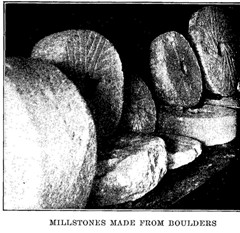Even after reaching the mill he might have an unhappy time in waiting his turn; for since a great many men had come from many directions at the same time, they had to be served in the order in which they reached the place. A kind miller would always run his mill night and day so that the journey home could be begun as soon as possible.
Suppose people now living in Marion County had to go to Burlington, one hundred miles away, to mill; or those at Fort Dodge had to go to Des Moines or Oskaloosa as they did at one time; and in going suppose they had to drive a slow ox team. In these hurried days they would probably think that a great hardship. When mills were built near enough to permit a man to go and to return with his flour on the same day, it was getting quite comfortable to live anywhere.
The water mills, to be sure, could not run all the time; for the water might be low in the hot summer season, or it might freeze deep in the winter. When anything interfered with the water power mill the miller had to use the old horse mill until there was enough water again. After steam power was used to run mills there was no more trouble of that kind.
It was about 1848 that the first steam mill was put up in Davenport, and when it was ready to grind wheat a grand opening was held. At the feast of good things served to those who were invited the bread was made from flour ground that very day in the new mill. The new bread perhaps was much better when eaten with roast turkey and chickens and roast pig, and the pies and cakes which the three hundred guests ate, than bread would have been when eaten alone.
The Iowa counties which had good streams had plenty of mills after they had become well settled. Scott County, for example, had many more than any other county near it, and people came from all directions with their “grist”, or grain, to be ground. The “Honest Miller” was a nickname once given to the owner of a mill who in this early time always took just his rightful share of the flour; for the miller received his pay for his work in a small part of the flour made.




